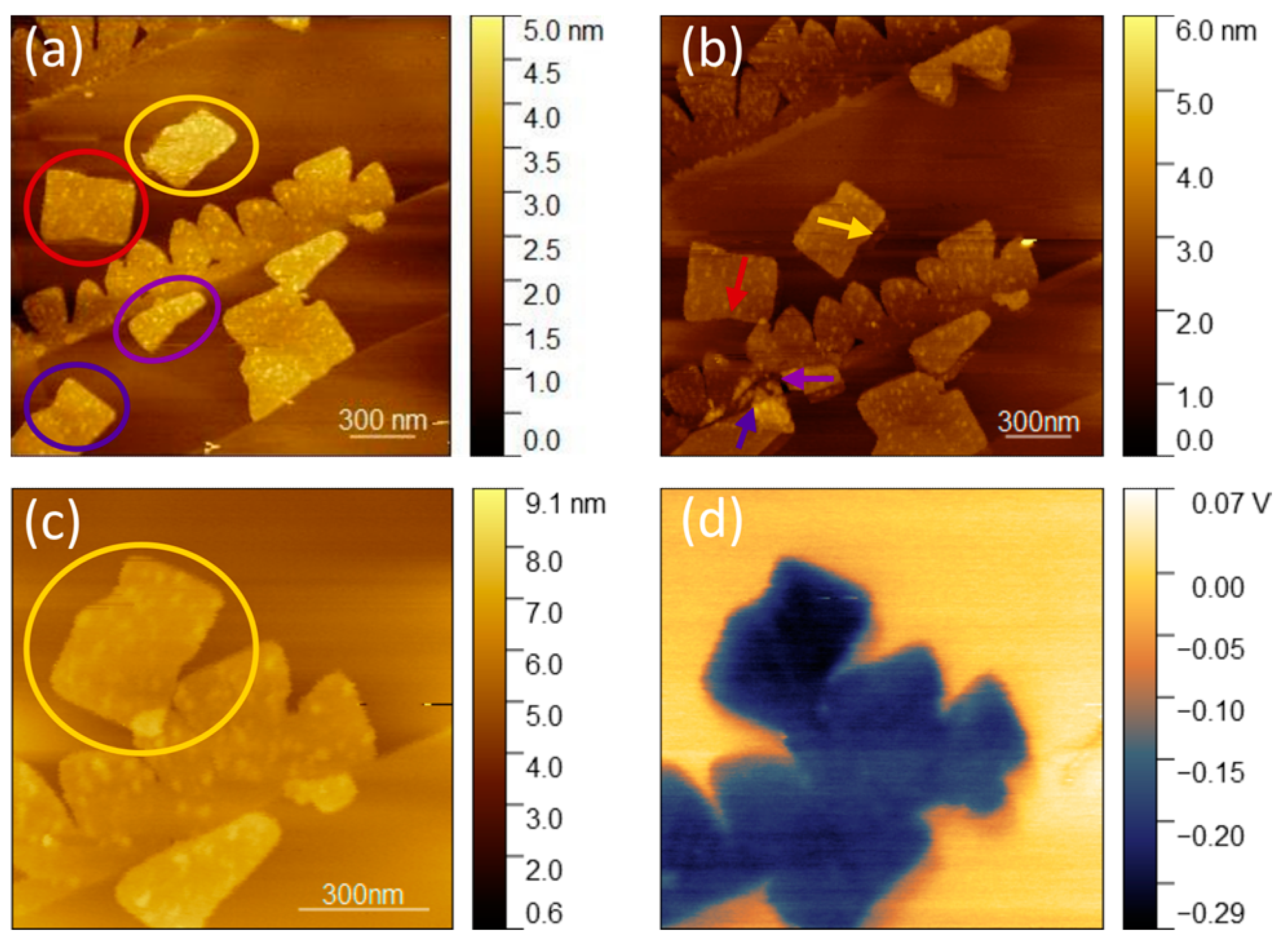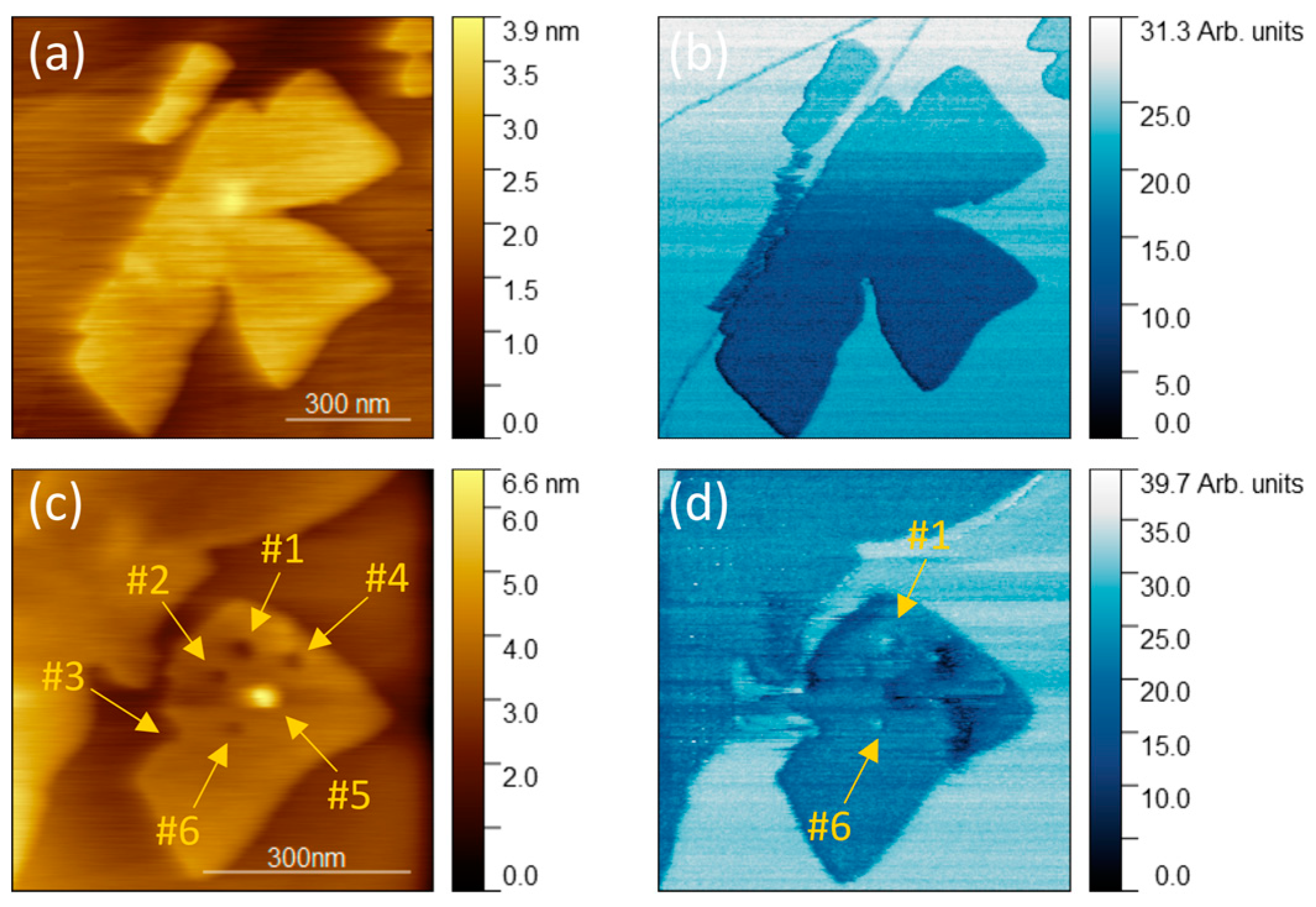Electrostimulation and Nanomanipulation of Two-Dimensional MoO3-x Layers Grown on Graphite
Abstract
:1. Introduction
2. Materials and Methods
3. Results
3.1. Chemical Analysis of MoO3-x Monolayer
3.2. Morphology and Stability of MoO3-x Monolayers
3.3. Electrical Characterisation
4. Conclusions
Supplementary Materials
Author Contributions
Funding
Data Availability Statement
Acknowledgments
Conflicts of Interest
References
- Alam, H.; Chowdhury, S.; Roy, A.; Wu, X.; Ge, R.; Rodder, M.A.; Chen, J.; Lu, Y.; Stern, C.; Houben, L.; et al. Wafer-Scalable Single-Layer Amorphous Molybdenum Trioxide. ACS Nano 2022, 16, 3756–3767. [Google Scholar] [CrossRef] [PubMed]
- Hu, X.; Liu, K.; Cai, Y.; Zang, S.-Q.; Zhai, T. 2D Oxides for Electronics and Optoelectronics. Small Sci. 2022, 2, 220008. [Google Scholar] [CrossRef]
- Zhou, F.; Zhou, Z.; Chen, J.; Choy, T.H.; Wang, J.; Zhang, N.; Lin, Z.; Yu, S.; Kang, J.; Wong, H.S.P.; et al. Optoelectronic Resistive Random Access Memory for Neuromorphic Vision Sensors. Nat. Nanotechnol. 2019, 14, 776–782. [Google Scholar] [CrossRef]
- Balendhran, S.; Deng, J.; Ou, J.Z.; Walia, S.; Scott, J.; Tang, J.; Wang, K.L.; Field, M.R.; Russo, S.; Zhuiykov, S.; et al. Enhanced Charge Carrier Mobility in Two-Dimensional High Dielectric Molybdenum Oxide. Adv. Mater. 2013, 25, 109–114. [Google Scholar] [CrossRef] [PubMed]
- Kröger, M.; Hamwi, S.; Meyer, J.; Riedl, T.; Kowalsky, W.; Kahn, A. Role of the Deep-Lying Electronic States of MoO3 in the Enhancement of Hole-Injection in Organic Thin Films. Appl. Phys. Lett. 2009, 95, 123301. [Google Scholar] [CrossRef]
- Rahman, F.; Zavabeti, A.; Rahman, M.A.; Arash, A.; Mazumder, A.; Walia, S.; Sriram, S.; Bhaskaran, M.; Balendhran, S. Dual Selective Gas Sensing Characteristics of 2D α-MoO3-x via a Facile Transfer Process. ACS Appl. Mater. Interfaces 2019, 11, 40189–40195. [Google Scholar] [CrossRef]
- Ma, Z.; Shi, X.M.; Nishimura, S.; Ko, S.; Okubo, M.; Yamada, A. Anhydrous Fast Proton Transport Boosted by the Hydrogen Bond Network in a Dense Oxide-Ion Array of α-MoO3. Adv. Mater. 2022, 34, 2203335. [Google Scholar] [CrossRef] [PubMed]
- Huang, F.; Liu, H.; Li, X.; Wang, S. Enhancing Hole Injection by Processing ITO through MoO3 and Self-Assembled Monolayer Hybrid Modification for Solution-Processed Hole Transport Layer-Free OLEDs. Chem. Eng. J. 2022, 427, 131356. [Google Scholar] [CrossRef]
- Marchal, W.; Verboven, I.; Kesters, J.; Moeremans, B.; De Dobbelaere, C.; Bonneux, G.; Elen, K.; Conings, B.; Maes, W.; Boyen, H.G.; et al. Steering the Properties of MoOx Hole Transporting Layers in OPVs and OLEDs: Interface Morphology vs. Electronic Structure. Materials 2017, 10, 123. [Google Scholar] [CrossRef]
- Hosseini, M.A.; Ranjbar, M. Optical Hydrogen Sensing by MoO3 Films Deposited by a Facile Flame Synthesis Method. Appl. Surf. Sci. 2023, 618, 156641. [Google Scholar] [CrossRef]
- Cheng, P.; Shi, L.; Li, W.; Fang, X.; Cao, D.; Zhao, Y.; Cao, P.; Liu, D.; He, D. Efficient Regulation of Polysulfides by MoS2/MoO3 Heterostructures for High-Performance Li-S Batteries. Small 2023, 19, 2206083. [Google Scholar] [CrossRef] [PubMed]
- Yun, Q.; Ge, Y.; Chen, B.; Li, L.; Wa, Q.; Long, H.; Zhang, H. Hybridization of 2D Nanomaterials with 3D Graphene Architectures for Electrochemical Energy Storage and Conversion. Adv. Funct. Mater. 2022, 32, 2202319. [Google Scholar] [CrossRef]
- de Castro, I.A.; Datta, R.S.; Ou, J.Z.; Castellanos-Gomez, A.; Sriram, S.; Daeneke, T.; Kalantar-zadeh, K. Molybdenum Oxides—From Fundamentals to Functionality. Adv. Mater. 2017, 29, 1701619. [Google Scholar] [CrossRef]
- Holler, B.A.; Crowley, K.; Berger, M.H.; Gao, X.P.A. 2D Semiconductor Transistors with Van Der Waals Oxide MoO3 as Integrated High-κ Gate Dielectric. Adv. Electron. Mater. 2020, 6, 2000635. [Google Scholar] [CrossRef]
- Molina-Mendoza, A.J.; Lado, J.L.; Island, J.O.; Niño, M.A.; Aballe, L.; Foerster, M.; Bruno, F.Y.; López-Moreno, A.; Vaquero-Garzon, L.; Van Der Zant, H.S.J.; et al. Centimeter-Scale Synthesis of Ultrathin Layered MoO3 by van Der Waals Epitaxy. Chem. Mater. 2016, 28, 4042–4051. [Google Scholar] [CrossRef]
- Cho, E.; Cha, S.; Kim, Y.; Kim, C. Transparent and Flexible Electrode Composed of a Graphene Multilayer Interlayer-Doped with MoO3. Org. Electron. 2020, 77, 105437. [Google Scholar] [CrossRef]
- Choi, D.K.; Kim, D.H.; Lee, C.M.; Hafeez, H.; Sarker, S.; Yang, J.S.; Chae, H.J.; Jeong, G.W.; Choi, D.H.; Kim, T.W.; et al. Highly Efficient, Heat Dissipating, Stretchable Organic Light-Emitting Diodes Based on a MoO3/Au/MoO3 Electrode with Encapsulation. Nat. Commun. 2021, 12, 2864. [Google Scholar] [CrossRef]
- Wu, Q.H.; Zhao, Y.; Hong, G.; Ren, J.G.; Wang, C.; Zhang, W.; Lee, S.T. Electronic Structure of MoO3-x/Graphene Interface. Carbon 2013, 65, 46–52. [Google Scholar] [CrossRef]
- Krukowski, P.; Piskorski, M.; Udovytska, R.; Kowalczyk, D.A.; Lutsyk, I.; Rogala, M.; Dąbrowski, P.; Kozłowski, W.; Łuszczyńska, B.; Jung, J.; et al. Graphene on Quartz Modified with Rhenium Oxide as a Semitransparent Electrode for Organic Electronics. Opto-Electron. Rev. 2022, 30, e141953. [Google Scholar] [CrossRef]
- Krukowski, P.; Kowalczyk, D.A.; Piskorski, M.; Dabrowski, P.; Rogala, M.; Caban, P.; Ciepielewski, P.; Jung, J.; Baranowski, J.M.; Ulanski, J.; et al. Work Function Tunability of Graphene with Thermally Evaporated Rhenium Heptoxide for Transparent Electrode Applications. Adv. Eng. Mater. 2020, 22, 1900955. [Google Scholar] [CrossRef]
- Kim, J.H.; Hyun, C.; Kim, H.; Dash, J.K.; Ihm, K.; Lee, G.H. Thickness-Insensitive Properties of α-MoO3 Nanosheets by Weak Interlayer Coupling. Nano Lett. 2019, 19, 8868–8876. [Google Scholar] [CrossRef] [PubMed]
- Kim, J.H.; Dash, J.K.; Kwon, J.; Hyun, C.; Kim, H.; Ji, E.; Lee, G.H. Van Der Waals Epitaxial Growth of Single Crystal α-MoO3 Layers on Layered Materials Growth Templates. 2D Mater. 2019, 6, 015016. [Google Scholar] [CrossRef]
- Cai, L.; McClellan, C.J.; Koh, A.L.; Li, H.; Yalon, E.; Pop, E.; Zheng, X. Rapid Flame Synthesis of Atomically Thin MoO3 down to Monolayer Thickness for Effective Hole Doping of WSe2. Nano Lett. 2017, 17, 3854–3861. [Google Scholar] [CrossRef] [PubMed]
- Kowalczyk, D.A.; Rogala, M.; Szałowski, K.; Kozłowski, W.; Lutsyk, I.; Piskorski, M.; Krukowski, P.; Dabrowski, P.; Belić, D.; Cichomski, M.; et al. Local Electronic Structure of Stable Monolayers of α-MoO3−x Grown on Graphite Substrate. 2D Mater. 2021, 8, 025005. [Google Scholar] [CrossRef]
- Kowalczyk, D.A.; Rogala, M.; Szałowski, K.; Belić, D.; Dąbrowski, P.; Krukowski, P.; Lutsyk, I.; Piskorski, M.; Nadolska, A.; Krempiński, P.; et al. Two-Dimensional Crystals as a Buffer Layer for High Work Function Applications: The Case of Monolayer MoO3. ACS Appl. Mater. Interfaces 2022, 14, 44506–44515. [Google Scholar] [CrossRef]
- Nečas, D.; Klapetek, P. Gwyddion: An Open-Source Software for SPM Data Analysis. Cent. Eur. J. Phys. 2012, 10, 181–188. [Google Scholar] [CrossRef]
- McKenna, K.; Shluger, A. The Interaction of Oxygen Vacancies with Grain Boundaries in Monoclinic HfO2. Appl. Phys. Lett. 2009, 95, 222111. [Google Scholar] [CrossRef]
- Greiner, M.T.; Chai, L.; Helander, M.G.; Tang, W.M.; Lu, Z.H. Metal/Metal-Oxide Interfaces: How Metal Contacts Affect the Work Function and Band Structure of MoO3. Adv. Funct. Mater. 2013, 23, 215–226. [Google Scholar] [CrossRef]
- Xie, W.; Su, M.; Zheng, Z.; Wang, Y.; Gong, L.; Xie, F.; Zhang, W.; Luo, Z.; Luo, J.; Liu, P.; et al. Nanoscale Insights into the Hydrogenation Process of Layered α-MoO3. ACS Nano 2016, 10, 1662–1670. [Google Scholar] [CrossRef]
- Ruan, J.A.; Bhushan, B. Frictional Behavior of Highly Oriented Pyrolytic Graphite. J. Appl. Phys. 1994, 76, 8117–8120. [Google Scholar] [CrossRef]
- Irfan; Ding, H.; Gao, Y.; Small, C.; Kim, D.Y.; Subbiah, J.; So,, F. Energy Level Evolution of Air and Oxygen Exposed Molybdenum Trioxide Films. Appl. Phys. Lett. 2010, 96, 243307. [Google Scholar] [CrossRef]
- Greiner, M.T.; Lu, Z.H. Thin-Film Metal Oxides in Organic Semiconductor Devices: Their Electronic Structures, Work Functions and Interfaces. NPG Asia Mater. 2013, 5, e55. [Google Scholar] [CrossRef]
- Kowalczyk, P.J.; Mahapatra, O.; Brown, S.A.; Bian, G.; Chiang, T.C. STM Driven Modification of Bismuth Nanostructures. Surf. Sci. 2014, 621, 140–145. [Google Scholar] [CrossRef]







| I–V Curve Number | Activation Voltage [V] |
|---|---|
| #1 | 1.1 |
| #2 | 2.1 |
| #3 | 4.9 |
| #4 | 3.9 |
| #5 | 1.8 |
| #6 | 3.0 |
Disclaimer/Publisher’s Note: The statements, opinions and data contained in all publications are solely those of the individual author(s) and contributor(s) and not of MDPI and/or the editor(s). MDPI and/or the editor(s) disclaim responsibility for any injury to people or property resulting from any ideas, methods, instructions or products referred to in the content. |
© 2023 by the authors. Licensee MDPI, Basel, Switzerland. This article is an open access article distributed under the terms and conditions of the Creative Commons Attribution (CC BY) license (https://creativecommons.org/licenses/by/4.0/).
Share and Cite
Nadolska, A.; Kowalczyk, D.A.; Lutsyk, I.; Piskorski, M.; Krukowski, P.; Dąbrowski, P.; Le Ster, M.; Kozłowski, W.; Dunal, R.; Przybysz, P.; et al. Electrostimulation and Nanomanipulation of Two-Dimensional MoO3-x Layers Grown on Graphite. Crystals 2023, 13, 905. https://doi.org/10.3390/cryst13060905
Nadolska A, Kowalczyk DA, Lutsyk I, Piskorski M, Krukowski P, Dąbrowski P, Le Ster M, Kozłowski W, Dunal R, Przybysz P, et al. Electrostimulation and Nanomanipulation of Two-Dimensional MoO3-x Layers Grown on Graphite. Crystals. 2023; 13(6):905. https://doi.org/10.3390/cryst13060905
Chicago/Turabian StyleNadolska, Aleksandra, Dorota A. Kowalczyk, Iaroslav Lutsyk, Michał Piskorski, Paweł Krukowski, Paweł Dąbrowski, Maxime Le Ster, Witold Kozłowski, Rafał Dunal, Przemysław Przybysz, and et al. 2023. "Electrostimulation and Nanomanipulation of Two-Dimensional MoO3-x Layers Grown on Graphite" Crystals 13, no. 6: 905. https://doi.org/10.3390/cryst13060905
APA StyleNadolska, A., Kowalczyk, D. A., Lutsyk, I., Piskorski, M., Krukowski, P., Dąbrowski, P., Le Ster, M., Kozłowski, W., Dunal, R., Przybysz, P., Ryś, W., Toczek, K., Kowalczyk, P. J., & Rogala, M. (2023). Electrostimulation and Nanomanipulation of Two-Dimensional MoO3-x Layers Grown on Graphite. Crystals, 13(6), 905. https://doi.org/10.3390/cryst13060905






